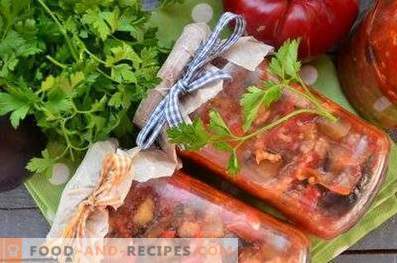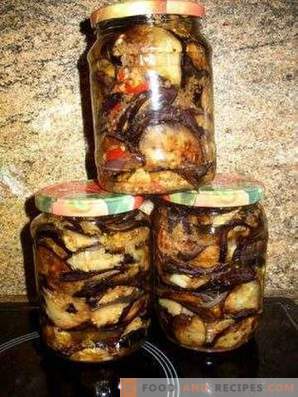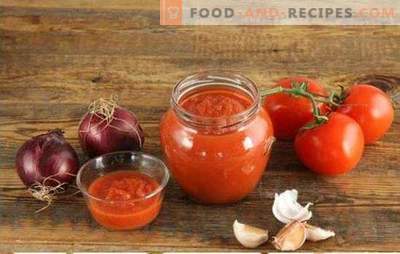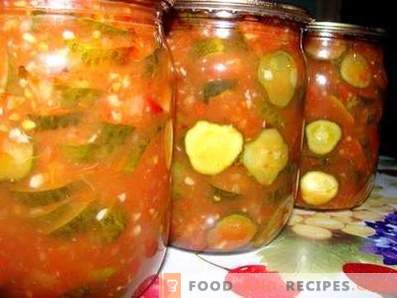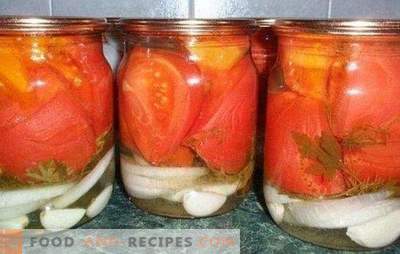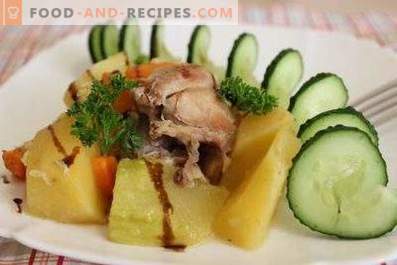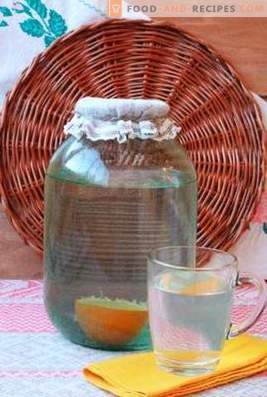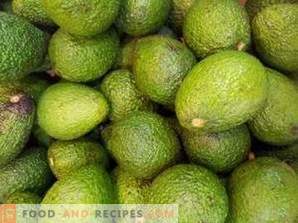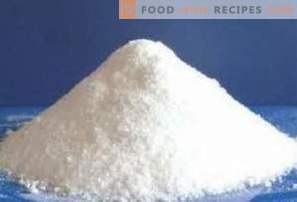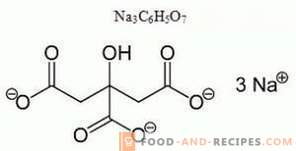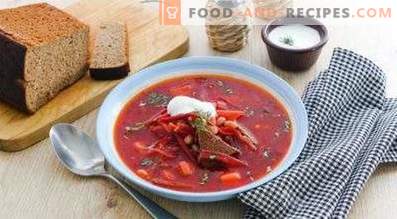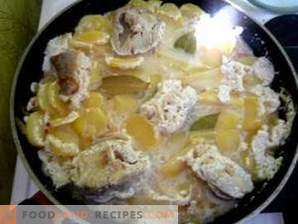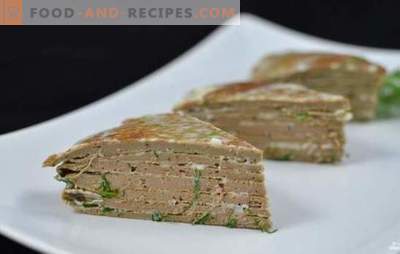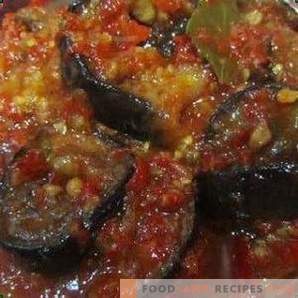
A popular name for the “grasses” is canned vegetables, which have a particularly spicy taste. “Teschin language” of eggplant for the winter is prepared according to several recipes. In all of them there are tomatoes, hot peppers and garlic, but in different quantities. Therefore, the appetizer can get a different degree of spice, with a pronounced taste of garlic or, on the contrary, muffled. Whatever recipe the hostess would prefer, the general principles of making this hot snack for the winter remain identical.
Cooking Features
When cooking a spicy snack of eggplants, garlic and hot pepper, there are several important points to consider:
- Eggplants before cooking snacks must be cut, not peeling, and soak for at least half an hour, then rinse with running water, dry. It is necessary to remove bitterness from them. The solution for soaking eggplants is usually prepared this concentration: a tablespoon of salt per liter of water.
- Small eggplants (up to 15 centimeters long) are best cut along thin slices from 3 to 5 millimeters thick. The eggplant slices so cut resemble tongues. Larger specimens can be cut into round or oval washers (if cut at an angle, the plates will be in the shape of an ellipse).
- Tomatoes are better to choose fleshy, from which a lot of tomato puree is obtained.
- Bitter pepper can be added with or without seeds. Seeds are the hottest part of the pepper. If you remove them, the finished dish from it will get a little less spicy.
- Peppers and garlic should be handled with gloves, as they can cause a burn, especially if they need to be cleaned a lot. After the hand, it is necessary to wash them well, as they may be left with pepper pairs - if you touch your eyes with unwashed hands, they will pinch and tear.
In order for the “Teschin tongue” to be stored for the whole winter, it is necessary to lay out the finished snack only over sterilized jars, hermetically sealed them with boiled lids, and also to observe the recipe.
The classic recipe for “cough tongue” of eggplants
Composition:
- eggplants - 4 kg;
- tomatoes - 1 kg;
- Bulgarian pepper - 1 kg;
- garlic - 5 heads;
- chilli pepper - 150 g;
- table vinegar (9%) - 100 ml;
- vegetable oil - 125 ml;
- granulated sugar - 100 g;
- salt - 40 g.
Method of preparation:
- Wash the eggplants, cut off the stalks. Cut into plates of the same shape. Put in the brine for an hour. Rinse under running water, let it drain.
- Wash spicy and sweet peppers, remove seeds from them, cut them into small pieces and roll through a meat grinder.
- Tomatoes wash. Remove the stalks, and on the opposite side make two shallow cuts with a sharp knife crosswise.
- Boil the water, dip the tomatoes in it and blanch them for 5 minutes.
- Put the tomatoes in cold water so that they quickly cool down. Take out and remove the skin from them. Cut each into 4-6 pieces, cutting the seal in the stalk area. Mince tomato slices through a meat grinder and mix tomato mash with pepper mass.
- Peel the garlic. Grind it with a meat grinder. Put in vegetable puree, mix well.
- Pour vinegar and oil into the vegetable mass, add salt with sugar, put the pan with vegetables on the fire.
- Cook over low heat until the mass boils.
- Put the eggplant “tongues” into the sauce and cook them in the sauce for half an hour. All this time you need to make sure that the snack is not burnt, if necessary, mix it.
- While the snack is being prepared, you can sterilize the jars and lids for them. You need to count on 6-7 liters of the finished product.
- Spread snacks in cans, roll them up and let them cool at room temperature.
The savory eggplant “Teschin tongue”, prepared according to the classic recipe, is well preserved all winter at temperatures up to 24 degrees, but still the lower the temperature, the better. The burning taste is due primarily to a large amount of garlic, and then - bitter pepper.
Very sharp “Teschin language”
Composition:
- eggplants - 4 kg;
- tomatoes - 1 kg;
- Bulgarian pepper - 1 kg;
- garlic - 5 heads;
- chilli pepper - 0, 3 kg;
- table vinegar (9%) - 100 ml;
- vegetable oil - 125 ml;
- salt - 50 g;
- sugar - 40 g.
Method of preparation:
- Wash the eggplants. Cut the stalk. Cut the young fruits along, large - across. The thickness of the eggplant plates should be about half a centimeter.
- Pour the eggplants with salt (its amount is not included in the recipe) and leave for an hour and a half - during this time the salt will “pull” out of the “blue” solanine, because of which they have a bitter taste.
- Rinse the eggplants well to remove excess salt. Dry them with a napkin.
- Remove from the tomatoes, after washing them, the skin. It will be quite simple to make an incision in the shape of a cross on top of each vegetable and dip it in boiling water for just a couple of minutes. After it remains to cool the tomatoes, for example, dropping them in cold water, and remove them from the skin.
- Wash the sweet pepper, remove the seeds from it, cut each into 4 pieces.
- Wash the hot pepper and also remove the seeds from it.
- Peel the garlic.
- Skip tomatoes, sweet and hot peppers, garlic through a meat grinder, alternating between them. Stir the resulting vegetable mixture.
- Pour salt, sugar and vinegar into it.
- Fry eggplants until half cooked in oil on both sides.
- Sterilize the jars and lay in them a few spoons of sauce, fried eggplant “tongues”, again sauce, eggplants, and so on. The top layer should be the sauce.
- Put a towel in a large pot. Put on him the banks with the “Tonscheyn language”, covered with their covers. Fill the pot with water so that it can be at least “waist-high”. Sterilize 20 minutes, if the banks are half-liter, 30 minutes - if the liter.
- Roll up, turn over, wrap in a warm blanket. A day later, remove the blanket, remove the canned food for the winter.
This appetizer is sharper than a traditional recipe. Heat treatment in this case is minimal, which allows you to feel the taste of fresh vegetables: tomatoes, peppers, garlic. At the same time, oil is needed a little - only for roasting eggplants.
“Teschin language” without oil
Composition:
- eggplants - 2 kg;
- Bulgarian pepper - 0, 5 kg;
- hot pepper (capsicum) - 0, 2 kg;
- garlic - 1 head;
- tomatoes - 2 kg;
- table vinegar (9%) - 70 ml;
- sugar - 80 g;
- salt - 25 g.
Method of preparation:
- Cut the eggplants in plates, soak them in salt water for an hour, rinse and dry.
- Peel the garlic and pass it through the press.
- Wash the tomatoes, pour in boiling water, peel. Cut into small pieces and place in a saucepan.
- Peel the peppers by removing the seeds. Turn through the meat grinder. Do the same with hot pepper.
- Combine peppers (both hot and sweet) with tomatoes. Put the pot on the fire and simmer the vegetable mass for 25 minutes.
- Put salt, sugar, vinegar in it, cook for another 5 minutes and put eggplants in the mixture.
- Boil another 25 minutes and add garlic.
- After 5 minutes, remove from heat and place on prepared cans.
- Banks tighten. After they cool down, store for winter.
“Teschin language”, cooked without oil, is stored no worse than other similar blanks, because it contains a lot of sugar and pepper, which are natural preservatives. The taste of garlic in it will also be less pronounced than in the snack according to the classic recipe.
“Teshchin language” of eggplants will appeal to lovers of savory snacks, whatever the recipe it was prepared for.

